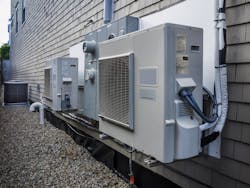NEC: Air Conditioning and Refrigerating Equipment — Part 6
Article 440, Part VI provides the requirements for motor-compressor and branch-circuit overload protection. Application and selection [440.52] is broken down into protection of the motor-compressor [440.52(A)] and protection of motor-compressor control apparatus and branch-circuit conductors [440.52(B)].
To protect the motor-compressor, you have four choices. The text for each one is longish, but to summarize:
- Separate overload relay.
- Integral thermal protector.
- Fuse or inverse time circuit breaker.
- Protective system.
To protect the motor-compressor control apparatus and branch-circuit conductors, you also have four choices. And they are almost identical to the ones for protecting the motor.
If you use an overload relay or other device for motor overload protection and it isn’t capable of opening short circuits, you must protect it with fuses or inverse time circuit breakers [440.53].
Motor compressors and equipment on a 15A or 20A 120V circuit, or 15A 208V or 240V circuit:
- If not cord and plug connected, must have both overload protection [440.54(A)] and sufficient time delay to permit starting [440.54(B)].
- If cord and plug connected, must have overload protection [440.55(A)] and sufficient time delay to permit starting [440.54(C)]. Also, the rating of the plug and receptacle or cord connector must not exceed 20A and 125V or 15A at 250V [440.44(B)].
About the Author

Mark Lamendola
Mark is an expert in maintenance management, having racked up an impressive track record during his time working in the field. He also has extensive knowledge of, and practical expertise with, the National Electrical Code (NEC). Through his consulting business, he provides articles and training materials on electrical topics, specializing in making difficult subjects easy to understand and focusing on the practical aspects of electrical work.
Prior to starting his own business, Mark served as the Technical Editor on EC&M for six years, worked three years in nuclear maintenance, six years as a contract project engineer/project manager, three years as a systems engineer, and three years in plant maintenance management.
Mark earned an AAS degree from Rock Valley College, a BSEET from Columbia Pacific University, and an MBA from Lake Erie College. He’s also completed several related certifications over the years and even was formerly licensed as a Master Electrician. He is a Senior Member of the IEEE and past Chairman of the Kansas City Chapters of both the IEEE and the IEEE Computer Society. Mark also served as the program director for, a board member of, and webmaster of, the Midwest Chapter of the 7x24 Exchange. He has also held memberships with the following organizations: NETA, NFPA, International Association of Webmasters, and Institute of Certified Professional Managers.
